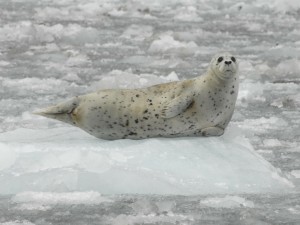17 December 2015
Harbor seals hang out on glacier ice
Posted by lhwang

Harbor seals resting on glacier ice calved from a tidewater glacier in McBride Inlet, Glacier Bay National Park, Alaska.
Credit: Jamie Womble/U.S. National Park Service.
by Emily Benson
Harbor seals are the most widespread pinniped species in the world. They range as far south as Baja California in Mexico, and as far north as Artic Canada and Greenland. In the colder areas of that vast distribution, they sometimes make themselves at home on floating chunks of ice below tidewater glaciers.
Glaciers are constantly on the move, flowing slowly downhill under the force of their own weight. When that path leads them into the ocean, they’re called tidewater glaciers. During the summer, harbor seals, up to several thousand at a time, congregate in Alaska’s tidewater glacier fjords.
To understand how future changes in glacier calving rates and ice availability might affect harbor seals, scientists in Alaska decided to find out more about how seals use the ice that exists now.
“We didn’t even know what was there, and what type of ice they were using,” said Jamie Womble, a wildlife biologist at the National Park Service Glacier Bay Field Station in Juneau, Alaska.
Womble and her colleagues at the University of Alaska Fairbanks addressed that knowledge gap by taking aerial photographs of Johns Hopkins Inlet in Glacier Bay National Park. They measured the amount of available ice habitat and the number and location of seals using it. In 2007, they surveyed the inlet on four days in June, when mother seals are nursing pups, and four days in August, when seals are molting.
Icebergs were larger and more common in the inlet in June than in August, Womble and her coauthors reported at the 2015 American Geophysical Union Fall Meeting in San Francisco. They also found that harbor seals were more abundant on the ice earlier in the season.

Harbor seals may spend time on glacier ice to avoid marine predators and preserve energy. Credit: Jamie Womble/U.S. National Park Service.
“There might be tons of ice, but it’s not all usable ice,” Womble said. “They’re typically using somewhat flat pieces.”
Level icebergs may offer mother seals a more stable platform for resting and nursing than sites on land, where daily tide fluctuations force the animals to move into the water or further up the beach, using up precious energy stores, Womble said. That’s important for the pups, which only stay with their mothers for a few weeks and need to nurse as much as they can during that time, she added.
Glacier ice may also offer harbor seals a refuge from marine predators like orcas and Steller sea lions, Womble said.
Though the glacier at the head of Johns Hopkins Inlet is currently advancing, Glacier Bay is a dynamic environment where other glaciers are retreating, some so far that they no longer reach the ocean. When that happens, harbor seals are left with fewer options for a safe place to stay, according to Womble.
“When ice goes away – retreats completely to land – that habitat goes away,” Womble said. And that could be a problem for harbor seals in Glacier Bay. While the species is not threatened globally, the Glacier Bay population has declined by up to 14 percent since 1992, Womble said.
– Emily Benson is a science communication graduate student at UC Santa Cruz. You can follow her on twitter at @erbenson1, or via her website.


 GeoSpace is a blog on Earth and space science, managed by AGU’s Public Information staff. The blog features posts by AGU writers and guest contributors on all sorts of relevant science topics, but with a focus on new research and geo and space sciences-related stories that are currently in the news.
GeoSpace is a blog on Earth and space science, managed by AGU’s Public Information staff. The blog features posts by AGU writers and guest contributors on all sorts of relevant science topics, but with a focus on new research and geo and space sciences-related stories that are currently in the news.